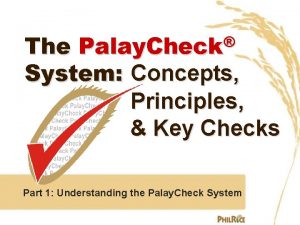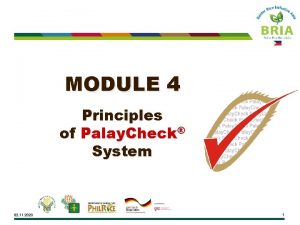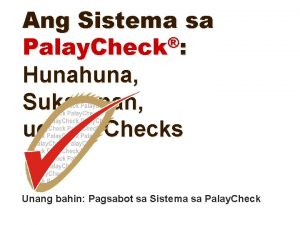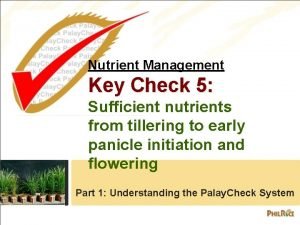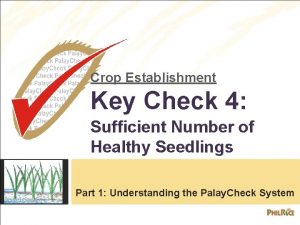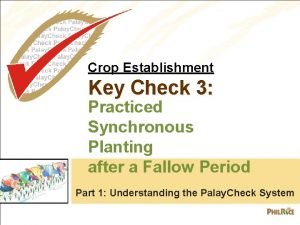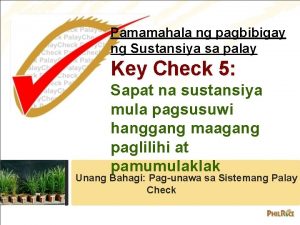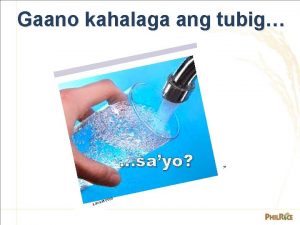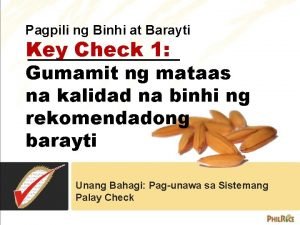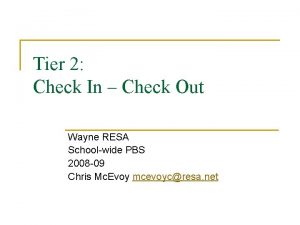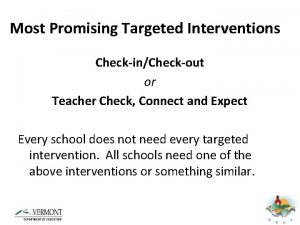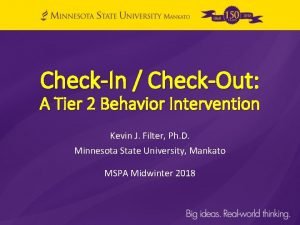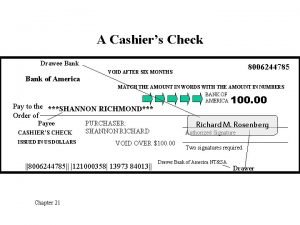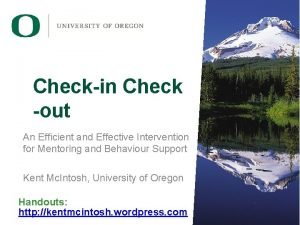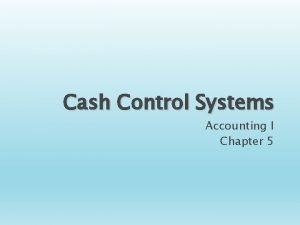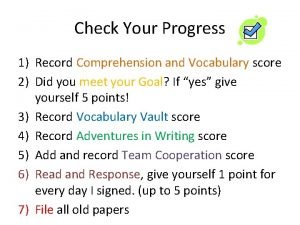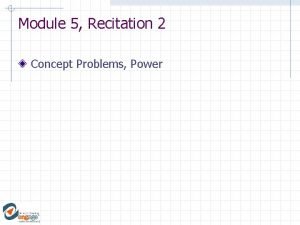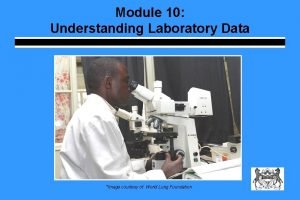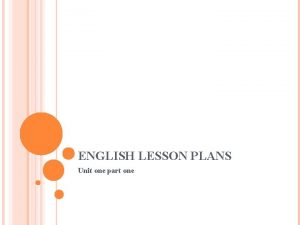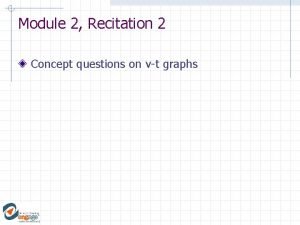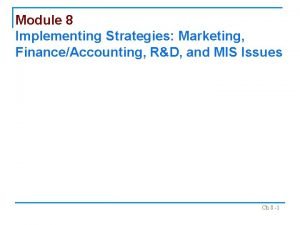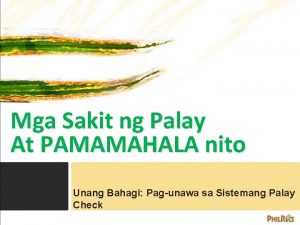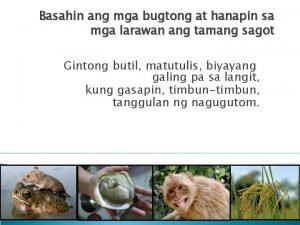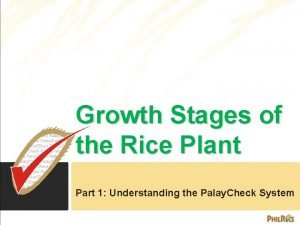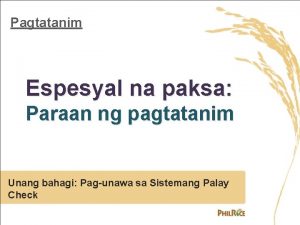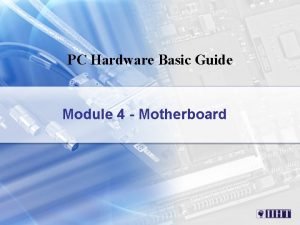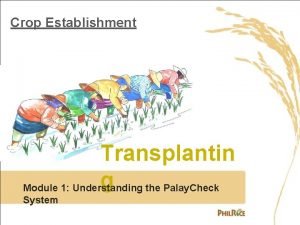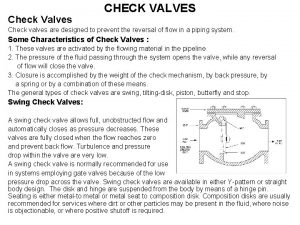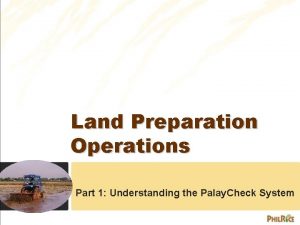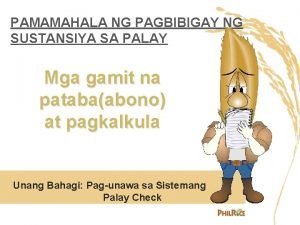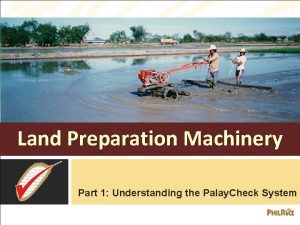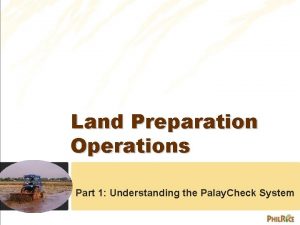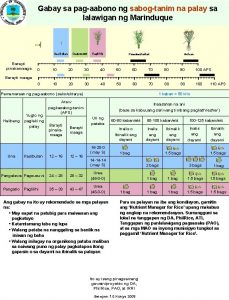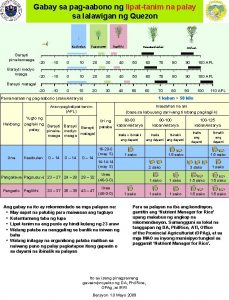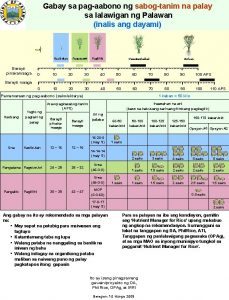MODULE 4 Principles of Palay Check System 02













































- Slides: 45

MODULE 4 Principles of Palay. Check® System 02. 11. 2020 1

The Race Gap between rice production and utilization is widening 02. 11. 2020 2

…Pop’n increasing faster than prodn Population is expected to increase by about 2 millions per year, which means more mouth to feed and hence, more rice demanded. 02. 11. 2020 3

Outcomes • • • Narrate the history and definition of the Palay. Check System; List and explain the principles of the Palay. Check system; Illustrate and describe the Palay. Check cycle; Recite the Key Check slogan, importance, recommendation and assessment of the eight Key Checks; Compare their farm practices to the Key Checks; and Raise the interest of other farmers or groups in the Palay. Check System. 02. 11. 2020 4

Structure Lesson No. Lesson 1 Lesson 2 Lesson 3 Lesson 4 02. 11. 2020 Description Definition and Background of the Palay. Check System The Four Palay. Check Principle (HIKE) The Palay. Check Cycle The Eight Key. Checks 5

To raise production… NPT Increase Yield Ceiling Production Narrow Yield Gap 02. 11. 2020 Super Hybrid Rice Improve Irrigation Improve Crop Mgt. The more plausible option is to improve crop mgt… 6

What can Palay. Check do? Encourages farmers to manage their crops according to targets… Guides farmers on what to achieve and how to achieve them… Helps farmers to learn from their experience and improve their crop management in the future… 02. 11. 2020 7

MONITORING BOARD Farmer Cooperator Key Check No. of Key Checks Achieved Grain Yield (t/ha) Gross Margin (P/ha) 1 2 3 4 5 6 7 8 Alvin (farmer partner) 8 6. 15 38, 160 Ben 8 7. 20 45, 080 Charlie 8 4. 65 25, 560 Cris 7 5. 37 32, 000 Doming 7 5. 53 33, 350 Gary 7 5. 58 34, 350 Jojo 7 5. 72 35, 550 Larry 7 4. 20 23, 580 Mando 7 4. 40 25, 260 Paul 7 4. 71 26, 050 Robert 7 4. 49 24, 220 Romeo 6 3. 90 22, 360 Roger 6 5. 15 25, 830 Vic 6 5. 35 27, 350 Willy 60 93 5 3. 50 16, 300 100 80 87 93 87 Range Mean = 5. 06 Mean = 29, 000 Achievement of Checks (%) 02. 11. 2020 87 =5– 8 8

Lesson 1 Definition and Background of the Palay. Check System 02. 11. 2020 9

Outcomes Discuss the history of the Palay. Check System Define Palay. Check System 02. 11. 2020 10

Structure History of the Palay. Check System Definition of Palay. Check 02. 11. 2020 11

The Beginnings of Palay. Check § It takes off from Australia’s Ricecheck system, which contributed significantly to increasing Australia’s yield from about 6 t/ha in 1987 to almost 10 t/ha in 2000. 02. 11. 2020 Australian rice yield, 1970 to 2000 (Source: FAOSTAT) 12

The Beginnings of Palay. Check § In 2000, rice experts recommended the use of the Ricecheck system to FAO to close in a sustainable manner the yield gap in irrigated areas. § In Feb 2004, the Phil. Rice-FAO project on “Strengthening the Development & Use of RICM for Food Security & Poverty Alleviation “ started in partnership with selected LGUs. § From mid-2006, its nationwide promotion started. It is the current platform of Phil. Rice’s “Location-specific Technology Development” program. 02. 11. 2020 13

What is Palay. Check? § An integrated crop management system for rice growing is viewed as a production system with many component factors that must be managed in an integrated, holistic manner to optimize production, with less Single-problem damage to Broader, or the environment Seed-based componentholistic, technologies focused, integrated (varieties + integrated mgt agrochemical technologies s) (IPM, INM, (ICM) IWM) Changes in technological recommendations for crop management 02. 11. 2020 14

What is Palay. Check? 02. 11. 2020 • It provides recommendations on what to do & what to achieve based on best management practices for a particular agro-ecological condition. These may not necessarily be supported by research results. • Then, it seeks to adapt these recommendations at the farm-level, taking into account the interactions among management practices & other factors affecting yield, grain quality, & environment. 15

An analogy Ivatans’ Houses http: //www. flickr. com/photos/bigberto/4722536431/sizes/z/in/photostream/ http: //picasaweb. google. com/lh/view? q=ivatan+house&uname=gavhug&psc=G& cuname=gavhug&filter=1#5174174728338541170 Ifugaos’ http: //picasaweb. google. com/gavhug/Tawi 21207543 PM#5033559525377767618 02. 11. 2020 Badjaos’ 16

Lesson 2 PALAYCHECK PRINCIPLES 02. 11. 2020 17

Outcome & Structure • Explain the Palay. Check Principles. • Insights on HIKE o Holistic, Integrated Crop Management o Input-Outcome Model o Key. Checks o Experiential Group Learning 02. 11. 2020 18

Four Palay. Check Principles (HIKE) 1 Holistic, integrated crop management • Rice growing is a production system, thus holistic , integrated crop management is essential. • ICM aims to maximize or optimize the beneficial impacts 02. 11. 2020 19

Four Palay. Check Principles (HIKE) 1 • Holistic, integrated crop management Management practices & result areas under the different crop management areas are interdependent & interrelated. They have a combined impact on yield, grain quality, & environmental outcome. Seed & variety selection Nutrient managem ent 02. 11. 2020 Land preparation Water managem ent Crop establishmen t Pest managem ent Harvest managem ent 20

Four Palay. Check Principles (HIKE) 2 Input-Outcome • The INPUTS (practices) must achieve the optimum level of OUTPUTS (results of practices) at all growth stages & management areas to get the optimum OUTCOMES (combined effects of outputs on yield, quality, profitability, & environment). INPUT OUTCOME fertilizer rates, timing no. of panicles/m 2 yield grain quality • Palay. Check gives simple, objective recommendations for both INPUTS & OUTPUTS. These recommendations may be revised based on new findings & experiences. 02. 11. 2020 21

Four Palay. Check Principles (HIKE) 3 Key checks and assessment of keychecks • KEY CHECKS are the key outputs & are the most important determinants of yield, grain quality, & environmental outcomes. Use them as targets & benchmarks (assessment of keychecks) to evaluate farmers’ success or failure in managing the rice crop. Crop Mgt Outputs Area/Inputs Land • Levelled field Of the 3 outputs, preparation • Uniform bund this is the key -Clean/repair height output. Thus, dikes • Breakdown of the Key Check. 02. 11. 2020 -Plow field -Harrow 2 x -Level organic materials 22

Four Palay. Check Principles (HIKE) 3 Key checks • There may be more than one key check per management area. KEY CHECKS may also be location-specific. For example, in Philippines & Indonesia, ‘used certified seeds’ is a key check; but in Australia, where all farmers use certified seeds, it is not included as key check anymore. • 02. 11. 2020 Although studies imply a higher yield & gross margin with more key checks, it is more important to be able to understand/ explain why such yield was achieved. 23

Four Palay. Check Principles (HIKE) 4 • Experiential group learning This is best attained through EXPERIENTIAL GROUP LEARNING, with assistance from facilitative & technically-competent resource persons. 02. 11. 2020 • EXPERIENTIAL (or discovery-based) GROUP LEARNING promotes collaborative learning among farmers & between resource persons & farmers, making learning less intimidating. Learning is handson, shared, & guided. • Farmers must first identify their strengths (practices contributing to improving outcomes) & weaknesses (practices limiting level of outcomes) in crop management before these can be changed. 24

IMPORTANCE OF PALAYCHECK FFS F F S Understanding key checks Giving feedback on key checks Learning from each other Recognizing management weaknesses & need to improve 02. 11. 2020 25

Four Palay. Check Principles (HIKE) 1 3 Holistic, integrated crop management 2 Input-Outcome Key checks & assessment of KC 4 Experiential group learning Let’s review! 02. 11. 2020 26

Lesson 3 THE PALAYCHECK CYCLE 02. 11. 2020 27

Outcomes After the discussion (lesson) everyone should be able to: • Illustrate and clearly understand the Palay. Check cycle; Define Palay. Check cycle; Describe the activities in the Palay. Check cycle; and Explain the factors affecting the Palay. Check cycle. 02. 11. 2020 28

Structure • Discussion on Palay. Check Cycle 02. 11. 2020 29

The Palay. Check Cycle Palay. Check Key Checks & Recommendations Climate, agroecosystem, soils, etc. . PLANNING Specify what to do/ change and achieve CHANGING KNOWLEDGE, UNDERSTANDIN G, AND ATTITUDES TO MANAGEMENT MANAGING THE CROP Undertake specific practices to achieve Key Checks MONITORING Observe, measure, and record the results achieved HARVESTING IDENTIFYING Record yield, MANAGEMENT quality, and STRENGTHS prices received AND WEAKNESSES COMPARING AND INTERPRETING RESULTS Determine Key Check achievement and yield relationships Farmers’ knowledge & experiences Resource & finance availability Neighbor/peer group knowledge, attitudes, etc. . 02. 11. 2020 30

Lesson 4 Key. Checks 02. 11. 2020 31

Outcomes After the discussion (lesson) everyone should be able to: Explain the recommendations for each of the Key. Checks Compare the farm practices with the Key. Checks. Raise the interest of other farmers or groups on the Palay. Check System. 02. 11. 2020 32

Structure • Discussion on the 8 Key. Checks 02. 11. 2020 33

The Eight Key Checks of Palay. Check 1 Used high quality seeds of a recommended variety relatively pure; clean; full & uniform in size; & have minimum germination rate of 85%. less weeds healthy seedlings 10 -15% increase in yield 02. 11. 2020 more fertilizer-responsive; stronger pest resistance fast & uniform growth resulting in efficient crop establishment & harvesting activities 34

The Eight Key Checks of Palay. Check 2 No high & low soil spots after final levelling less water to fill up more uniform water distribution easier drainage more efficient fertilizer application less weed incidence better snail management uniform crop maturity timely harvesting 02. 11. 2020 35

The Eight Key Checks of Palay. Check 3 Practiced synchronous planting after a fallow period efficient use of irrigation 02. 11. 2020 less spread of pest damage 36

The Eight Key Checks of Palay. Check 4 Sufficient number of healthy seedlings compete better against weeds better root growth Better nutrient uptake More efficient nutrient use Healthy seedlings 02. 11. 2020 Sowing right amount of seeds Transplanting right amount of seedlings 37

The Eight Key Checks of Palay. Check 5 Sufficient nutrients at tillering to early panicle initiation & flowering NUTRIENTS oversupply sufficient pest damage uniform growth lodging uniform panicle dev’t 02. 11. 2020 attainment of yield potential undersupply less tillers slow growth low grain weight 38

The Eight Key Checks of Palay. Check 6 Avoided excessive water or drought stress that could affect the growth and yield of the crop • Water transports nutrients from the soil to the plant. • Adequate water supply facilitates land preparation & ensures good crop establishment. • It also promotes seedling vigor & normal crop growth and development, with minimal lodging. 02. 11. 2020 • There is better nutrient uptake with right 39

The Eight Key Checks of Palay. Check 7 No significant yield loss due to pests • Knowledge of the interactions of the rice crop with the biotic factors, agroecosystem, & the crop management system help in understanding how to minimize pest damage. • Correct pest identification & application of ICM (i. e. resistant variety; date & method of crop establishment; fertilizer & water management; & • Proper pesthelp. management results pesticide use) also in good seed or grain quality. 02. 11. 2020 40

The Eight Key Checks of Palay. Check 8 Cut & threshed the crop at the right time REAPING too early timely good grain large % quality of immature & halfhigh market filled value grains low MR, low grain quality 02. 11. 2020 consumer acceptance too late grain shatterin g milling breakag e low grain quality 41

Crop Mgt Area Key Checks Seed & variety selection 1) Used high quality seeds of the recommended variety Land preparation 2) No high & low soil spots after final levelling Crop establishment 3) Practiced synchronous planting after fallow period 4) Sufficient number of healthy seedlings Nutrient management 5) Sufficient nutrients at tillering to early panicle initiation and flowering Water management 6) Avoided excessive water or drought stress that could affect the growth & yield the crop yield loss due to 7) Noofsignificant Let’s review! pests Pest management 8) Cut & threshed the crop at the right time Harvest 02. 11. 2020 42

Conclusion • Do quick assessment via “pass the ball exercise” • Review learning outcomes • Solicit questions from participants • Summarize the key points • Congratulate and ask the participants how to apply what they have learned. 02. 11. 2020 43

Thank You! 02. 11. 2020 44

For more information, please contact: Dr. Aurora M. Corales Phil. Rice Focal Person – BRIA FARMERS amcorales@yahoo. com http: //www. philrice. gov. ph Mr. Matthias Radek Chief Advisor GIZ Agriculture-DPP Projects matthias. radek@giz. de http: //www. better-rice-initiative-asia. org/ 02. 11. 2020 Credit Philippine Rice Research Institute 45
 Key check 8
Key check 8 What is palay check system
What is palay check system Palay check system tagalog
Palay check system tagalog Palay key check 5
Palay key check 5 Key check 9
Key check 9 Keycheck
Keycheck Abono sa palay
Abono sa palay Bakit mahalaga ang palay
Bakit mahalaga ang palay Sumisibol na halaman drawing
Sumisibol na halaman drawing Check in check out system
Check in check out system Check in check out behavior intervention
Check in check out behavior intervention Behavior check in check out sheet
Behavior check in check out sheet Behavior check in check out sheet
Behavior check in check out sheet Check in check out
Check in check out Jobbank
Jobbank Polygonal check and raster scan check are types of
Polygonal check and raster scan check are types of Check in and check out intervention
Check in and check out intervention Velocity and acceleration quick check
Velocity and acceleration quick check How to endorse a check to someone else
How to endorse a check to someone else Check your progress 1
Check your progress 1 Module 2 concept check
Module 2 concept check Module 10 knowledge check
Module 10 knowledge check Module eleven lesson one self check quiz
Module eleven lesson one self check quiz Module 2 concept check
Module 2 concept check C device module module 1
C device module module 1 Principles of marketing module 9
Principles of marketing module 9 Principles of marketing quarter 2
Principles of marketing quarter 2 Principles of marketing module 6
Principles of marketing module 6 Business ethics and social responsibility module 5
Business ethics and social responsibility module 5 Principles of marketing module 2 relationship marketing
Principles of marketing module 2 relationship marketing Principles of marketing module 10
Principles of marketing module 10 Principles of marketing module 8
Principles of marketing module 8 Lara palay
Lara palay Punan ang dayagram na nagpapakita ng sanhi at bunga
Punan ang dayagram na nagpapakita ng sanhi at bunga Paggawa ng balangkas worksheet
Paggawa ng balangkas worksheet Sakit ng palay
Sakit ng palay Yamang napapalitan
Yamang napapalitan Likas na yaman ng uzbekistan
Likas na yaman ng uzbekistan Stages of rice plant
Stages of rice plant Lara palay
Lara palay Sergio palay
Sergio palay Mga hakbang sa pagtatanim ng halaman
Mga hakbang sa pagtatanim ng halaman Module 4 topic 2 components of the space management system
Module 4 topic 2 components of the space management system System administration module
System administration module Closed system earth
Closed system earth Circularory system
Circularory system
